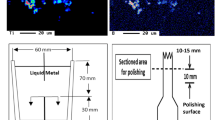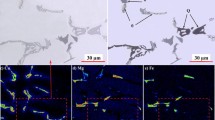Abstract
The principal aim of the present research study was to investigate the effects of minor additions of zirconium on phase precipitation in 354 alloys under very slow solidification rates. The results showed that reactions corresponding to precipitation of Cu-containing phases are also observed in the 354 alloy at temperatures below 500 °C. Zirconium reacts only with Ti, Si, and Al. The Zr-rich intermetallic phases observed in this study appear in two different forms: the phase (Al,Si)2(Zr,Ti) containing high levels of silicon which is block-like in form, and the phase (Al,Si)3(Zr,Ti) containing high levels of aluminum, which appears in needle-like form. There is no observable poisoning effect on the refinement of grain size after the addition of Zr to the alloys investigated, as was observed from the macrostructures of the thermal analysis samples obtained at high solidification rates, for the alloys containing Zr and Ti. In thermal analysis experiments carried out at the higher solidification rate, namely 4 °C s−1, there is an observable reaction within the temperature range of 667–671 °C which appears to be related to the precipitation of Zr-rich phases; it was not possible to observe this reaction at the lower solidification rate of 0.35 °C s−1 generally used in thermal analysis.














Similar content being viewed by others
References
H. Amini, A. Moloodi, M. Golestanipour, E.Z.V. Karimi, Recycling of aluminum alloy turning scrap via cold pressing and meeting with SALT flux. J. Mater. Process. Technol. 209, 3138–3142 (2009)
H.K. Buxmann, Ecological aspects of the use of aluminium in cars, with particular regard to recycling techniques. Resour. Conserv. Recycl. 10(1–2), 17–23 (1994)
C.H. Cáceres, Transient environmental effects of light alloy substitutions in transport vehicles. Mater. Des. 30(8), 2813–2822 (2009)
M. Easton, W.Q. Song, T. Abbott, A comparison of the deformation of magnesium alloys with aluminum and steel in tension, bending and buckling. Mater. Des. 27, 935–946 (2006)
P. Sepehrband, R. Mahmudi, F. Khomamizadeh, Effect of Zr addition on the aging behavior of A319 aluminum cast alloy. Scr. Mater. 52, 253–257 (2005)
R. Mahmudi, P. Sepehrband, H.M. Ghasemi, Improved properties of A319 aluminum casting alloy modified with Zr. Mater. Lett. 60, 2606–2610 (2006)
J.D. Robson, P.B. Pragnell, Modeling Al3Zr dispersoid precipitation in multi-component aluminum alloys. Mater. Sci. Eng., A 352, 240–250 (2003)
J.E. Hatch, Aluminum: Properties and Physical Metallurgy (ASM, Materials Park, 1984)
L. Bäckerud, G. Chai, J. Tamminen, Solidification Characteristics of Aluminum Alloys, Vol. 2: Foundry Alloys (AFS/SKANALUMINIUM, Des Plaines, 1990)
J. Tamminen, Thermal analysis for investigation of solidification mechanisms in metals and alloys (Doctoral dissertation, University of Stockholm, Sweden, 1988)
S.G. Shabestari, S. Ghodrat, Assessment of modification and formation of intermetallic compounds in aluminum alloy using thermal analysis. Mater. Sci. Eng., A 467(1–2), 150–158 (2007)
W. Chen, Y. Wang, J. Qiang, C. Dong, Bulk metallic glasses in the Zr–Al–Ni–Cu system. Acta Mater. 51, 1899–1907 (2003)
L.F. Mondolfo, Aluminum Alloys: Structure and Properties (Butterworths, London, 1976)
N.A. Belov, D.G. Eskin, A.A. Aksenov, Multicomponent Phase Diagrams: Applications for Commercial Aluminum Alloys (Elsevier, Oxford, 2005)
L.A. Dobrzanski, R. Maniara, J. Sokolowski, W. Kasprzak, Effect of cooling rate on the solidification behaviour of AC AlSi7Cu2 alloy. J. Mater. Process. Technol. 191, 317–320 (2007)
W. Kurz, D.J. Fisher, Fundamentals of Solidification, 4th Revised Editio (TransTech. Publications Ltd., Uetikon-Zuerich, 1998)
J. Hernandez-Sandoval, Improving the Performance of 354 Type Alloy (PhD thesis, Université du Québec à Chicoutimi, Chicouimi, Quebec, Canada, 2010)
T. Sato, A. Kamio, G.W. Lorimer, Effects of Si and Ti additions on the nucleation and phase stability of the L12-type phase in Al–Zr alloys. Mater. Sci. Forum 217–222, 8895–8900 (1996)
H.W. Kerr, J. Cisse, G.F. Bolling, On equilibrium and non-equilibrium peritectic transformations. Acta Metall. 22, 677–686 (1974)
J.L. Murray, A. Peruzzi, J.P. Abriata, The Al–Zr (aluminum–zirconium) system. J. Phase Equilib. 13, 277–291 (1992)
Acknowledgments
The authors would like also to thank Amal Samuel for enhancing the quality of the images and figures employed in this article.
Author information
Authors and Affiliations
Corresponding author
Rights and permissions
About this article
Cite this article
Hernandez-Sandoval, J., Samuel, A.M., Valtierra, S. et al. Thermal Analysis for Detection of Zr-Rich Phases in Al–Si–Cu–Mg 354-Type Alloys. Inter Metalcast 11, 428–439 (2017). https://doi.org/10.1007/s40962-016-0080-0
Published:
Issue Date:
DOI: https://doi.org/10.1007/s40962-016-0080-0




